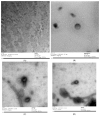Evaluating the Phenotypic and Genomic Characterization of Some Egyptian Phages Infecting Shiga Toxin-Producing Escherichia coli O157:H7 for the Prospective Application in Food Bio-Preservation
- PMID: 36009807
- PMCID: PMC9404725
- DOI: 10.3390/biology11081180
Evaluating the Phenotypic and Genomic Characterization of Some Egyptian Phages Infecting Shiga Toxin-Producing Escherichia coli O157:H7 for the Prospective Application in Food Bio-Preservation
Abstract
Shiga toxin-producing E. coli (STEC) is considered a worldwide public health and food safety problem. Despite the implementation of various different approaches to control food safety, outbreaks persist. The aim of study is to evaluate the applicability of phages, isolated against STEC O157:H7, as prospective food bio-preservatives. Considering the relatively wide host range and greatest protein diversity, two phages (STEC P2 and P4) from four were furtherly characterized. Complete genome analysis confirmed the absence of toxins and virulence factors-encoding genes. The results confirmed the close relation of STEC P2 to phages of Myoviridae, and STEC P4 to the Podoviridae family. The phages retained higher lytic competence of 90.4 and 92.68% for STEC P2 and P4, respectively with the HTST pasteurization. The strong acidic (pH 1) and alkaline (pH 13) conditions had influential effect on the surviving counts of the two phages. The lowest survivability of 63.37 and 86.36% in STEC P2 and P4 lysate, respectively appeared in 2% bile salt solution after 3 h. The results confirmed the strong effect of simulated gastric fluid (SGF) on the survivability of the two phages comparing with simulated intestinal fluid (SIF). Therefore, the two phages could be applied as a natural alternative for food preservation.
Keywords: Shiga toxin-producing Escherichia coli; bacteriophage; biological characterization; food bio-preservation; genome sequence.
Conflict of interest statement
The authors declare no conflict of interest.
Figures














Similar articles
-
Phage biocontrol of enteropathogenic and Shiga toxin-producing Escherichia coli during milk fermentation.Lett Appl Microbiol. 2013 Jul;57(1):3-10. doi: 10.1111/lam.12074. Epub 2013 Apr 24. Lett Appl Microbiol. 2013. PMID: 23551112
-
Application of bacteriophages in simultaneously controlling Escherichia coli O157:H7 and extended-spectrum beta-lactamase producing Escherichia coli.Appl Microbiol Biotechnol. 2018 Dec;102(23):10259-10271. doi: 10.1007/s00253-018-9399-1. Epub 2018 Sep 29. Appl Microbiol Biotechnol. 2018. PMID: 30267128
-
Genomic Characterization of Two Shiga Toxin-Converting Bacteriophages Induced From Environmental Shiga Toxin-Producing Escherichia coli.Front Microbiol. 2021 Feb 25;12:587696. doi: 10.3389/fmicb.2021.587696. eCollection 2021. Front Microbiol. 2021. PMID: 33716997 Free PMC article.
-
Shiga toxins and stx phages: highly diverse entities.Microbiology (Reading). 2015 Mar;161(Pt 3):451-62. doi: 10.1099/mic.0.000003. Epub 2014 Dec 5. Microbiology (Reading). 2015. PMID: 25479836 Review.
-
Shiga toxin-producing Escherichia coli.Adv Appl Microbiol. 2014;86:145-97. doi: 10.1016/B978-0-12-800262-9.00003-2. Adv Appl Microbiol. 2014. PMID: 24377855 Review.
Cited by
-
Lytic Spectra of Tailed Bacteriophages: A Systematic Review and Meta-Analysis.Viruses. 2024 Dec 4;16(12):1879. doi: 10.3390/v16121879. Viruses. 2024. PMID: 39772189 Free PMC article.
References
-
- Rabinowitz R.P., Donnenberg M.S. In: Enteric Infections and Immunity. Paradise L.J., Bendinelli M., Friedman H., editors. Springer USA; Boston, MA, USA: 1996. pp. 101–131.
LinkOut - more resources
Full Text Sources
Molecular Biology Databases

